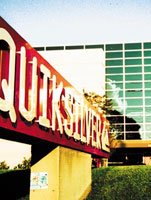Surfwear Makers Push Demand for O.C. Real Estate
Southern California apparel companies are finding it’s cool to be in the O.C.
Surfwear companies especially have found operating in California’s Orange County to their liking. Growth in the sector has spurred a new wave of migration to the area and contributed to record real estate prices.
An Orange County address, once just happenstance because most brand inventors lived there, is now part of apparel companies’ raison d’ecirc;tre.
In the past couple years, having an Orange County corporate headquarters has taken on added significance. It means validation and product visibility, according to company representatives.
“It’s really the epicenter of our industry,” said John Sabo, brand manager for Redsand, a beach line that moved last month from San Diego County to a space near the Irvine Spectrumin Irvine, Calif. Miami-based Perry Ellis International Inc. acquired the brand last fall.
“You have to be here to be more competitive,” Sabo said. “By being here, you’re close to your key accounts, as well as the hiring base.”
Where the action is
Most heavy hitters in surf apparel— including Quiksilver Inc., the Ocean Pacific Apparel Corp., Volcom, Hurley, Billabong, Oakley Inc., Split, Lost Enterprises and Pacific Sunwear of California Inc.—have set up shop in Orange County. Lifestyle brands such as Paul Frank Industries Inc., Von Zipper Ltd. and Black Flys also have their headquarters in Orange County, as do retailer The Wet Seal Inc. and upscale manufacturer St. John Knits.
Visibility is the main objective. With a Huntington Beach, San Clemente or even Irvine address, companies gain more clout—their backyards are filled with the world’s best surfers, skateboarders, BMXers and other action-sports athletes.
And in this day of instant access, consumers surprisingly know where many companies are based, said apparel company representatives. In the past few years, sponsors have moved to Orange County to host spectacles like the U.S. Open of Surfing, the Vans World Championship of Skateboarding and the AVP Volleyball tournaments. Companies are looking to get close to the action.
Rip Curl of Carlsbad, Calif., recently opened a 1,600-square-foot showroom in downtown Huntington Beach. The new showroom is across from the municipal pier, the site of the U.S. Open of Surfing, which last summer attracted more than 90,000 spectators on its final day of competition. The hefty lease rates didn’t bother Rip Curl, which placed more significance on brand building.
“The showroom puts Rip Curl at ground zero within the surf industry and allows us the opportunity to strengthen relationships with premier accounts from across the nation,” said Mike Martin, Rip Curl’s national sales manager.
The showroom will serve as both a sales product-presentation area and a marketing platform to showcase new products.
Other companies have been on the move, as well. Ray’s Apparel, distributor of Op and Split, expanded operations and opened a new headquarters at the Irvine Spectrum. Sole Technology Inc., maker of Etnies and Eacute;s apparel and footwear, relocated its STI research lab from the University of Massachusetts to Lake Forest, Calif. The company also opened a skate park near its new headquarters.
Last year, Quiksilver expanded its Huntington Beach headquarters by 100,000 square feet; the space now comprises 750,000 square feet. The manufacturer of apparel, wetsuits, eyewear and other products has been on an amazing growth spurt and is on track to crack $1 billion in sales this year.
Keeping a close watch on its primary customer base has been key to Quiksilver’s business, said Chief Operating Officer Greg Ziegler. When Quiksilver looked for a new headquarters a few years ago, the company looked in Los Angeles, the Inland Empire and other areas before settling on Huntington Beach.
“We’re a surf company. We wanted to be close to the beach, but we also wanted a facility that we can grow into,” Ziegler said. “This is where it all started. It’s the central hub of what’s hip and cool.”
Oakley used the same criteria when it completed its 500,000-square-foot Foothill Ranch, Calif.–based headquarters in 1997.
“We are a youth lifestyle brand, and there is no other region in the U.S. where youth culture, climate and action sports collide as well as they do in Orange County,” said Gar Jackson, director of corporate communications for Oakley, which recently expanded from its core eyewear product into men’s and women’s apparel. “Where else can you surf in the morning and snowboard in the afternoon?
“This is the mecca of action sports,” Jackson said. “Therefore, we wouldn’t even consider being anywhere else.”
Retailer Pacific Sunwear also saw longterm value in having an O.C. address. Last year, the company spent $12 million for a 480,000-square-foot headquarters on a 19-acre site near Interstates 55 and 91 in Anaheim, Calif.
“This is where most of our vendors are,” said PacSun’s Carl Womack. “We were looking for a reason to stay. We moved four times previously, and we had plenty of growth and felt confident about stepping out and doing this long term.”
Supply and demand
The demand for Orange County real estate has driven up prices. Property is at a premium. Small swatches of vacant land called “in-fill sites” command prices up to $20 per square foot, according to Los Angeles real estate company CB Richard Ellis.
For the fourth quarter of 2003, median home prices climbed to a record $533,000. That has made it difficult for the county’s employment base to live and work in the same area, said Jack Kyser, chief economist with the Los Angeles County Economic Development Corp.
“Orange County has a good, diversified base,” Kyser said. “The main drawback is the high home prices, so a lot of people are working in Orange County and living in Riverside and San Bernardino counties. That’s a long commute.”
Commercial real estate prices have remained stable.
The influx of tenants has kept industrial real estate vacancies at about 8 percent.























